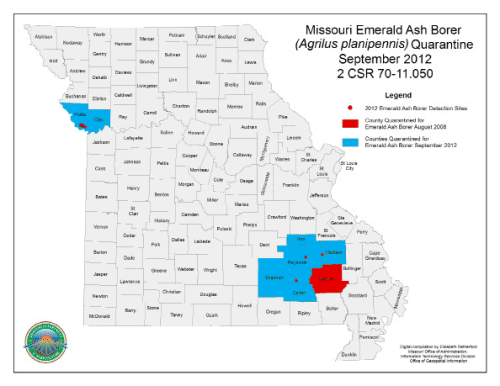Green Horizons
Volume 16, Number 4Fall 2012
Hank Stelzer, MU Forestry Extension
In mid-July, an alert arborist answering a service call to remove a dead ash tree in Platte County near Parkville, discovered the presence of the emerald as borer (EAB). His finding has been confirmed by the Missouri Department of Agriculture and the USDA.
While not a threat to human or pet health, nor will it damage wooden homes or structures, it is 100 percent fatal to Missouri's ash trees; blue, green, and white ash.
Prior to this find, EAB was thought to be present only in Wayne County, near the town of Greenville in Southeast Missouri. Along with the Kansas City find, adult males have also been captured in routine survey traps in Madison and Reynolds County.
 |
| EAB is now confirmed in the Missouri Counties of Madison, Reynolds, and Wayne; and also in Metro Kansas City Platte County. Due to the close proximity of these EAB populations are to county lines, the Missouri Department of Agriculture has included the counties of Carter, Clay, Iron, and Shannon to the quarantine area. |
But, the Kansas City discovery is more troubling because while ash trees account for only four trees out of every hundred in native forests of the Show-Me State, in urban areas they can account for up to one out of every four trees. In St. Louis, ash trees make up 40 percent of the tree canopy on the Gateway Arch grounds.
Researchers have been unable to determine exactly how, or even when, EAB came into Missouri. But, it is believed the insect hitch-hiked into the state in a load of firewood carried by a vacationer from another are as signs of the insect were first found in a campground in Wayne County on Lake Wappapello. Early indications are that the insect set up shop in Platte County several years ago. Efforts are now underway to determine the extent of this killer bug.
EAB is not a "business as usual" tree pest. It kills quickly and thoroughly. If left unchecked, EAB will destroy Missouri's ash trees and the many benefits they provide: shade, wildlife habitat, and contributing to a city's air and water quality.
While EAB is a serious threat, stop, take a deep breath, and consider these points before reaching for the insecticides or calling an arborist:
- Do you have ash trees on your property? Can you identify an ash tree? Several tree species look like an ash to the untrained botanist.
- Are your ash trees in good health? Ash trees with structural or pest problems unrelated to EAB or with a weak canopy (less than 50 percent exhibiting healthy, dark-green, leafy foliage) probably will not respond to any insecticides.
- If they are in good health, are they high-value trees? By this, do they provide shade on the west and south sides of your home? Were they planted by a child or grandchild, or in memory of someone? If so, then you will probably want to think about protecting them.
- Are you willing to be in this for the long haul? Once EAB arrives, insecticides are the only thing that will keep you ash tree alive. So, insecticide use could become a 20- to 30-year commitment until a replacement tree you plant nearby today can take its place.
- Use of insecticides is not recommended until an EAB infestation has been found within 15 miles of your location. Otherwise their use is a waste of money and an unnecessary chemical load on the environment.
- Once you decide to use insecticides, seriously consider calling a professional arborist. The arsenal of insecticides that have proven to be effective against EAB is limited and some chemicals can only be legally applied by licensed professionals.
Do not become a victim of a scam artist saying you have to protect every ash tree on your property. Remember to consider the points above. And if someone calls or knocks on your door saying EAB has been found in your area, check with the Missouri Department of Agriculture or the Missouri Department of Conservation first to find out exactly where EAB is. Then, if the bug is within 15 miles of your location, again work through the points above.
Go to www.eab.missouri.edu for more information on EAB and the latest developments. This website is linked to the national EAB website www.emeraldashborer.info where you access webinars and video clips to help you help your ash trees.